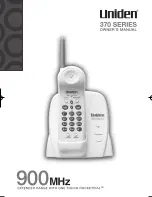
B-10
Rev 2.2, 10/31/94
Step 6. This tells the MRC that the slider that we want to program is slider 1.
Steps 7-18. These steps are the same for every slider and button that we are programming in
this example.
Step 19. This number (47h) comes from Appendix C under the heading "Data Structure Per
Program." This data structure is a table of offsets, each of which represents one parameter in
the edit buffer. Parameter 47h or 71d (47 hex equals 71 decimal) is the Event Type under Real
time MIDI Block 1. When the MRC sends the MIDI command represented by steps 10 through
20, the value sent at step 19 tells the 601 that the next data byte received gets stuffed into the
edit buffer at offset 71, which is the Real time MIDI Event Type.
Step 20. This step has a value of BYTE, which is the value represented by that slider's setting.
This is how you send a slider value to the 601 from the MRC.
Step 21. This step labels the slider so its function is a bit more obvious to humans.
Step 171. This step programs one of the switches (buttons) on the MRC. The buttons are a little
different than programming the sliders in that they only send one MIDI message per press, and
there is no way to create an ON/OFF toggle on one button. Instead, you must program one
button to send an OFF command, and the other button to send an ON command.
Step 172. Notice that we set the source to switch 1 instead of slider 1.
Step 185. Edit buffer offset 27h is the delay block mix control. Sending a 0 value to in step 186
turns the delay off by making the level of the wet portion of the delay mix to zero.
When using the delay controller setup, notice that the numbers shown in the MRC's display
range from 0-127. To turn these numbers into 601 numbers that match the front panel, you
must convert them via the parameter tables found at the end of Appendix C. For instance, on
the MRC, the feedback (
FB
) parameter varies from 0 to 127. If you set slider 3 on the MRC to
minimum and then listen to the 601's output, the result should be intense echo with no signs
of decay. Why is this? A glance at the Delay Feedback Table in Appendix C shows that sending
the 601 a feedback value of 0 results in maximum negative (reverse polarity) feedback. To set
the feedback to 0 (no feedback), you must set slider 3 on the MRC so the MRC's display
reads 64.
Setup 9: Delay Block
Controller
Setup 10: Real Time MIDI
Controller
SW 1
SW 2
SW 3
SW 4
SW 1
SW 2
SW 3
SW 4
kill
sine
triangle
random
n/a
n/a
n/a
n/a
SLIDER
1
SLIDER
2
SLIDER
3
SLIDER
4
SLIDER
1
SLIDER
2
SLIDER
3
SLIDER
4
delay1
delay2
feedback
mix
Event
type
select
2nd parm
offset
scale
SLIDER
5
SLIDER
6
SLIDER
7
SLIDER
8
SLIDER
5
SLIDER
6
SLIDER
7
SLIDER
8
ROC
filter
speed
depth
parm
n/a
n/a
n/a
Notes:
If you take the time to key in this program into your MRC, here's what you'll get:
Содержание 601
Страница 46: ...4 18 Rev 2 2 10 31 94 This page is blank believe it or not ...
Страница 48: ...4 20 Rev 2 2 10 31 94 Notes ...
Страница 50: ...5 2 Rev 2 2 10 31 94 Notes ...
Страница 70: ...7 16 Rev 2 2 10 31 94 Notes ...
Страница 72: ...8 2 Rev 2 2 10 31 94 Notes ...
Страница 74: ...9 2 Rev 2 2 10 31 94 Notes ...
Страница 78: ...11 2 Rev 2 2 10 31 94 Notes ...
Страница 126: ...D 12 Rev 2 2 10 31 94 Notes ...
Страница 138: ...G 8 Rev 2 2 10 31 94 Notes ...
















































